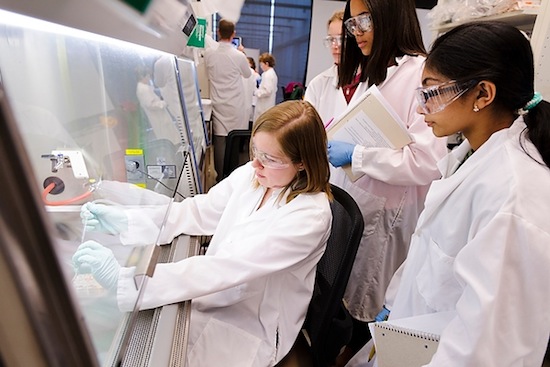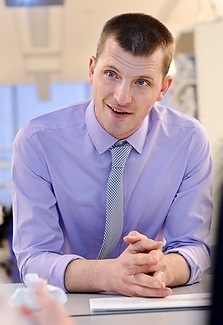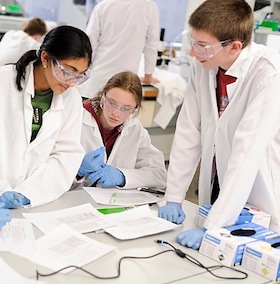With heart cells, middle schoolers learn the hard lessons of science

Middle-school students from the Madison Metropolitan School District’s Talented and Gifted program conduct drug-trial experiments with cardiomyocytes derived from induced stem cells during a weekly science class in a teaching lab at the Wisconsin Institutes for Discovery. At left is Irene Landrum, outreach staff with the Morgridge Institute for Research.
Photos: Jeff Miller
The drug trial is not off to an auspicious start. The cells are not cooperating.
“My control is a beater, but right now my other ones are not,” observes Morgridge Outreach Experiences assistant coordinator Irene Landrum as she works under a lab hood manipulating plates of cardiomyocytes, the workhorse cells of the human heart. “Let’s get these guys warmed up. If they’re too cold, they can stop beating.”
Peering over Landrum’s shoulder, four lab-coated and goggled Madison public middle school students take notes and ask questions about the cells and the agents they will be dosed with as part of an experiment in both science and science education.
The students are among a group of 12 in a Madison Metropolitan School District program called the Middle School Science Cohort, a program geared for students with a propensity for science and math. The setting is a teaching lab at the Wisconsin Institutes for Discovery, most likely the only place in the country — if not the world — where adolescent learners conduct real science using the kinds of stem cells on the front lines of modern biology.

Jeff Steele, teacher with the Madison Metropolitan School District.
The linchpins of the science experiment are the heart cells, which expand and contract in rhythm, even in the artificial confines of the laboratory dish. Made from stem cells and coaxed to become the heart muscle cells that make our hearts beat an average 72 times a minute, the pulsing cells will be exposed to different compounds to see how they react, providing an incremental bit of knowledge about the safety and efficacy of agents that could be used to treat heart disease.
The educational side of the project is intended to imbue in students the granular details of the scientific method: first, explore the literature of stem cells to see what is known and not known; next, devise a hypothesis and design an experiment to test the hypothesis.
Today is the test, where the cells will be put through their paces and, if all goes well, a new bit of knowledge will be added to what we know about cells that hold great promise for treating and understanding human disease.
The project, according to Jeff Steele, the middle school science teacher guiding the students, will culminate in a May 4 presentation at the Wisconsin Institutes for Discovery Saturday Science event where the students will complete the process by communicating their results. Steele is hoping the students will also have the opportunity to publish their findings, providing them with a stem-to-stern indoctrination into the research process.
Steele explains, “I am striving for what most science teachers strive for — to teach students science by really committing to science as a verb, not a string of nouns. It is a process that recognizes the value of practice and failure — success is a measure of fidelity.”
Building a learning experience around a real-life experiment helps give students not only hands-on experience with something as edgy as living human heart cells, but with the thought process of science and how to interpret and cope with the unexpected, including negative results.

The students review their findings from the heart cell experiment.
As Landrum and her student outreach assistants slide the plates of cardiomyocytes under a microscope, it is evident the cells are not beating as expected. As the students crowd a video feed from the microscope, their disappointment is palpable: “We got nothin’,” sighs Noah Zamzow-Schmidt, a lanky middle schooler in a lab coat several sizes too big.
Patiently, Landrum poses questions about why that might be: Is it the drug, verapamil, an agent used to treat hypertension, angina and cardiac arrhythmia? Was the dose too strong? Is it because the cells, notoriously finicky under the best of circumstances, didn’t get enough calcium?
The answer, of course, is not plain: “There are a lot of factors that can change your outcome,” says Emma Junga, another of Landrum’s student assistants. “You can only eliminate so many. Maybe bringing them from the safety cabinet to the microscope had an effect.”
While Steele and his students have clearly learned much about cell and developmental biology as they spent weeks studying and preparing for today’s test, “My role as a teacher is to help adolescents grapple with a thought process that may lead them to think a negative result is a failure,” he notes. “But science is fascinating when viewed as a compilation of wrong answers. We may not ever be able to say for certain that this fact is so, but we can say with great certainty that it is not so.”
Alluding to the uncooperative cells and the day’s experience, student Molly Jetzer frames one of the most enduring lessons of science: “Things don’t always work the way you think they will.”




